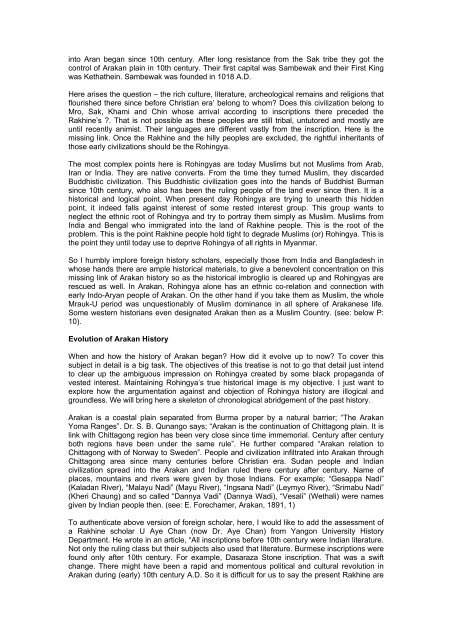Rohingya History: Myth and Reality - Rohingya Society In Malaysia
Rohingya History: Myth and Reality - Rohingya Society In Malaysia
Rohingya History: Myth and Reality - Rohingya Society In Malaysia
Create successful ePaper yourself
Turn your PDF publications into a flip-book with our unique Google optimized e-Paper software.
into Aran began since 10th century. After long resistance from the Sak tribe they got the<br />
control of Arakan plain in 10th century. Their first capital was Sambewak <strong>and</strong> their First King<br />
was Kethathein. Sambewak was founded in 1018 A.D.<br />
Here arises the question – the rich culture, literature, archeological remains <strong>and</strong> religions that<br />
flourished there since before Christian era’ belong to whom? Does this civilization belong to<br />
Mro, Sak, Khami <strong>and</strong> Chin whose arrival according to inscriptions there preceded the<br />
Rakhine’s ?. That is not possible as these peoples are still tribal, untutored <strong>and</strong> mostly are<br />
until recently animist. Their languages are different vastly from the inscription. Here is the<br />
missing link. Once the Rakhine <strong>and</strong> the hilly peoples are excluded, the rightful inheritants of<br />
those early civilizations should be the <strong>Rohingya</strong>.<br />
The most complex points here is <strong>Rohingya</strong>s are today Muslims but not Muslims from Arab,<br />
Iran or <strong>In</strong>dia. They are native converts. From the time they turned Muslim, they discarded<br />
Buddhistic civilization. This Buddhistic civilization goes into the h<strong>and</strong>s of Buddhist Burman<br />
since 10th century, who also has been the ruling people of the l<strong>and</strong> ever since then. It is a<br />
historical <strong>and</strong> logical point. When present day <strong>Rohingya</strong> are trying to unearth this hidden<br />
point, it indeed falls against interest of some rested interest group. This group wants to<br />
neglect the ethnic root of <strong>Rohingya</strong> <strong>and</strong> try to portray them simply as Muslim. Muslims from<br />
<strong>In</strong>dia <strong>and</strong> Bengal who immigrated into the l<strong>and</strong> of Rakhine people. This is the root of the<br />
problem. This is the point Rakhine people hold tight to degrade Muslims (or) <strong>Rohingya</strong>. This is<br />
the point they until today use to deprive <strong>Rohingya</strong> of all rights in Myanmar.<br />
So I humbly implore foreign history scholars, especially those from <strong>In</strong>dia <strong>and</strong> Bangladesh in<br />
whose h<strong>and</strong>s there are ample historical materials, to give a benevolent concentration on this<br />
missing link of Arakan history so as the historical imbroglio is cleared up <strong>and</strong> <strong>Rohingya</strong>s are<br />
rescued as well. <strong>In</strong> Arakan, <strong>Rohingya</strong> alone has an ethnic co-relation <strong>and</strong> connection with<br />
early <strong>In</strong>do-Aryan people of Arakan. On the other h<strong>and</strong> if you take them as Muslim, the whole<br />
Mrauk-U period was unquestionably of Muslim dominance in all sphere of Arakanese life.<br />
Some western historians even designated Arakan then as a Muslim Country. (see: below P:<br />
10).<br />
Evolution of Arakan <strong>History</strong><br />
When <strong>and</strong> how the history of Arakan began? How did it evolve up to now? To cover this<br />
subject in detail is a big task. The objectives of this treatise is not to go that detail just intend<br />
to clear up the ambiguous impression on <strong>Rohingya</strong> created by some black propag<strong>and</strong>a of<br />
vested interest. Maintaining <strong>Rohingya</strong>’s true historical image is my objective. I just want to<br />
explore how the argumentation against <strong>and</strong> objection of <strong>Rohingya</strong> history are illogical <strong>and</strong><br />
groundless. We will bring here a skeleton of chronological abridgement of the past history.<br />
Arakan is a coastal plain separated from Burma proper by a natural barrier; “The Arakan<br />
Yoma Ranges”. Dr. S. B. Qunango says; “Arakan is the continuation of Chittagong plain. It is<br />
link with Chittagong region has been very close since time immemorial. Century after century<br />
both regions have been under the same rule”. He further compared “Arakan relation to<br />
Chittagong with of Norway to Sweden”. People <strong>and</strong> civilization infiltrated into Arakan through<br />
Chittagong area since many centuries before Christian era. Sudan people <strong>and</strong> <strong>In</strong>dian<br />
civilization spread into the Arakan <strong>and</strong> <strong>In</strong>dian ruled there century after century. Name of<br />
places, mountains <strong>and</strong> rivers were given by those <strong>In</strong>dians. For example; “Gesappa Nadi”<br />
(Kaladan River), “Malayu Nadi” (Mayu River), “<strong>In</strong>gsana Nadi” (Leymyo River), “Srimabu Nadi”<br />
(Kheri Chaung) <strong>and</strong> so called “Dannya Vadi” (Dannya Wadi), “Vesali” (Wethali) were names<br />
given by <strong>In</strong>dian people then. (see: E. Forechamer, Arakan, 1891, 1)<br />
To authenticate above version of foreign scholar, here, I would like to add the assessment of<br />
a Rakhine scholar U Aye Chan (now Dr. Aye Chan) from Yangon University <strong>History</strong><br />
Department. He wrote in an article, “All inscriptions before 10th century were <strong>In</strong>dian literature.<br />
Not only the ruling class but their subjects also used that literature. Burmese inscriptions were<br />
found only after 10th century. For example, Dasaraza Stone inscription. That was a swift<br />
change. There might have been a rapid <strong>and</strong> momentous political <strong>and</strong> cultural revolution in<br />
Arakan during (early) 10th century A.D. So it is difficult for us to say the present Rakhine are


